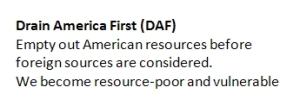Arguments have raged over use of the Arctic National Wildlife Refuge (ANWR), and will so again. Probably sooner rather than later.
One side says evidence of a large quantity of oil indicates life in the lower 48 states could be made more secure and comfortable with this resource – and it won’t bother anyone.
The other side, globalwarming.org , msnbc.msn.com, etc., believes that this staggeringly beautiful land should be left to the native American people who live on its shore and kept as a refuge for the arctic wildlife. The web abounds with breathtaking images of arctic wildlife and wilderness; also images of oil lines coexisting with graceful wildlife.
The fate of the Alaskan wilderness has been in contention since Pres Eisenhower granted Statehood in 1959. Stresses between the rights of Native Peoples who have been there for 10,000 years and those of corporate development interests who see it as a huge income source have played in court, in congress, in every single White House since then. ANWR was established by Pres Carter in 1980 in a bill that still is contentious.
Here is a picture of Alaska on top of the 48 contiguous U.S. states to show scale. ANWR is the region shown in orange and yellow. The orange region is the mountainous wildlife region, the source of the rugged pictures that abound on the web.
The yellow region is the coastal plains region, called the 1002 Area after the section in the ANWR legislation. This is the proposed location for the initial drilling. This site itself is a 8 km2 (2000 acre) spot near the western side of the coastal plain.
Kaktovak, a small village of native Americans, Inupiat or Iinuit (Canada) or Eskimo (elsewhere), is located on the peninsula into the Beaufort Sea.
As you can see from this map, ANWR is very close to the Prudhoe Bay oilfield that has fed Alaskan prosperity since the early 1970s.
The massive Trans Alaska Pipeline Service (TAPS) leads from Prudhoe Bay skirting the ANWR boundary, past Fairbanks and ends at Valdez on the south Alaskan coast. The image is from the Wikipedia, and was taken by Luca Galuzzi-www.galuzzi.com
How much oil in ANWR?
This is the point where commentators start to spew huge numbers the way fire hoses spew water. We enter the relm I have called the lies of large numbers. It is hard to see how raw numbers can impact your life; it is really easy to hide meaning and implications in lists of truly huge numbers.
Our basic numbers are from the U.S. EIA. The World used about 84 M bbl/day in 2009, while the U.S. used about 19 M bbl/day, slightly less than a quarter of the World’s demand.
Unit digression: These numbers have already become confusing. M means million (106) and bbl is shorthand for barrels of petroleum, needed because commodities use “barrel” b to mean other sizes. The petroleum industry (and our reference source) use bbl to mean exactly 42 U.S. gallons. Not just “gallon” because 1 US gallon is only slightly more than 4/5 of the gallon used in England (1 USgal = 0.833 UKgal) .
I once had a conversation with a British friend describing my great hybrid car with its 47 miles per gallon. He was totally unimpressed because his did better. It took a couple of days figure it out … my car actually made 56½ miles for his gallon.
 Every blog is read by people from around the world and must use internationally acceptable units. For the record: 1 USgal = 3.79 L
Every blog is read by people from around the world and must use internationally acceptable units. For the record: 1 USgal = 3.79 L
and 1 bbl = 119 L = 0.119 m3. All accurate to 3 digits.
Daily usage: World = 10.0 M m3, US = 2.27 M m3
We will reference the US rate, but a daily rate is of not much use. We want to know how many years a new site will last, not how many days or hours. Our actual baseline will be the US annual usage of ≈ 7 G bbl (830 M m3) = 365×19M. World annual usage in 2009 was ≈ 31 G bbl (3.7 G m3). G, “giga,” means 1 billion (in the US) or 1 thousand million (elsewhere).
The Question: How much oil does ANWR contain?
The Answer: 10.5 G bbl (1.25 G m3). This is the probable size (the mean) per the 1998 U.S. Geological Survey estimate of between 5.7 and 16 G bbl. The probable amount in the Federally controlled 1002 Area is 7.7 G bbl (920 M m3).
Visualizable ANWR size: ANWR probably holds 18 months at 2009 U.S. use rate (=12 mo×10.5/7). The 1002 Area holds a petroleum supply of 13 months (=12 mo×7.7/7) if dedicated to U.S. customers.
This is a tiny amount! All this political fuss for less than two years of oil if all went to U.S.? Not that all would flow south. Much would sell into the international market; not to serve the needs of the taxpayers who would pay for its development. If all went to the open market, ANWR could supply the world for 1.5 months (=12 mo×10.5/84).
Probable usage rates adds to the question. The oil companies cannot produce the pool in one large tank. One could imagine that the start and drain times might be similar to the Prudhoe Bay experience. Here is a use rate graph, per year. It shows the U.S. production with Prudhoe Bay added. ANWR production is added on. ANWR is projected (this estimate) to last for 35 years, similar to the Prudhoe Bay use.
The graph on the right is my own digitization of the ANWR data from the left-hand graph. It has bars for each of the years, and when the bars are laid out end to end, they add to about 10.5 G bbl total . So I believe Georgia Institute of Technology did it right and that this is a reasonable use rate for ANWR.
The maximum ANWR drain rate is 15% of the 2009 demand, sometime around year 11, pump rate peaks at 1 Gbbl/yr, only 2.8 M bbl/day (fraction of U.S. demand is 2.8/19=15%).
Only 12 of the 35 years exceed 7% of demand > 0.5 G bbl/yr (1.4 M bbl/day).
World market: the peak 1 Gbbl/yr (120 M m3) represents about 1.1% of demand (=1/84). ANWR is a trivial source on the world market, easily dominated by OPEC policies.
Prudhoe Bay comparisons: The field was discovered in 1968 and the first well was started but full production did not begin untill 1977 when TAPS became operational. Total reserves exceeded 25 G bbl (3.0 G m3), 2.4× the ANWR estimate. The site covers over 213,ooo acres (864 km2), with 1114 separate drilling locations. Maximum production occurred in 1979 with 1.5 M bbl/day (179 K m3) sent through TAPS. Production rate had dropped to 943,000 bbl/day by 2005.
It is highly unlikely that ANWR could produce the projected 2.8 M bbl/day from a small 8 km2 location,considering the max value for the very productive site at Prodhoe (1114 wells on 864 km2 ). Pumping will likely be at a lower, better distributed rate than projected.
Also, the environmental damage will almost certainly not be limited to the small size popularized on many pro-drilling internet sites.
How believable is the USGS 1998 survey? This is a good question. The ANWR survey was based on what had come out of Prudhoe and smaller surrounding sites, not from geological testing in the 1002 Area. It is a good time to examine what has happened at the NPRA.
The National Petroleum Reserve – Alaska (NPRA) is in the Western part of the Alaskan North Slope with Prudhoe Bay symmetrically placed between it and ANWR. This map is in the public domain from the USGS.
- 2002 –USGS original estimate, probable reserve of 10.6 G bbl.
This is similar to ANWR. - 2010 – USGS changed estimate, probable reserve of 0.896 G bbl.
This is about 8½% of the 2002 estimate; based on careful on-site tests.
Is it reasonable to suspect that ANWR and NPRA are small satillite pools around the original Prudhoe Bay reserve? Why would it be reasonable to not suspect this?
Summary:
It is true that there is very little oil in either the ANWR or the NPRA, although it is easy to get confused by the proliferation of all the millions and billions, bbls and m3s. Not enough in the ground to offer significant help as oil supplies dwindle, and ANWR is not a source for a terrorists-free energy supply. If we again made enemies of the OPEC nations, they could dominate our home prices by very small tweakings of their own petroleum contributions.
The ANWR issue is another example of the Drain America First movement. The DAF-iest strategy appears to be an attempt to put us us in a position of weakness. Get our reserves down, weaken our armed forces response capability, ruin our coherence as a people; then turn the screws. Shocking: this is the policy of allegedly right leaning political commentary.
BUT. Suppose there actually is 10.5 G bbl in ANWR, at $90/gallon of oil, this represents $945 billion US (=$90/bbl×10,500,000,000 bbl). We probably do not need to examine further the motivation of the forces behind these DAF-iest policies. I believe that personal family gain has driven most of the hard right-wing strategies for a very long time.
Draining ANWR has nothing at all to do with American energy security, or even the price of gasoline, although it could impact our military readiness. But it is understandable.
Charles J. Armentrout, Ann Arbor
2011 Jul 02
Have a comment? Click on the title of this post, go to bottom, let us know.
Listed under Natural Resources …thread Natural Resources > Arctic
Related posts: Click the INDEX button under the Banner picture










